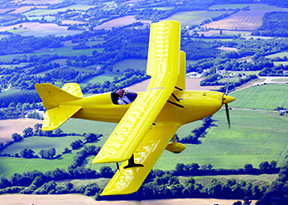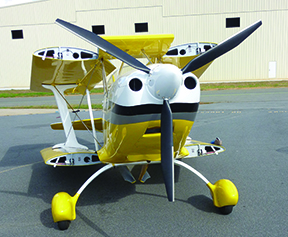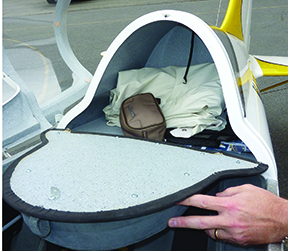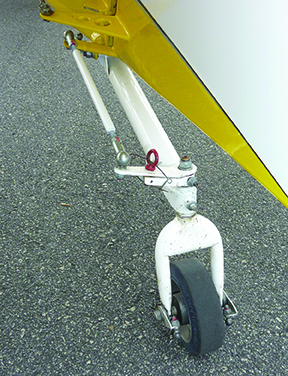Not to be too cynical about it, but at a distance, one high-wing light sport aircraft looks about like another and it’s no surprise they fly alike, too. In a world dominated by polished composite sameness, how to stand out? FK Lightplanes’ formula is a diminutive sport biplane it calls the FK12 Comet, which no one would ever mistake for an Evektor or a Remos at any distance.

In fact, if one goal of the LSA rule was to spur creativity, FK ought to be in line for some sort of award, given how unusual the FK12 is and for another of its designs, the FK14, which sports, in one version, a low wing and two side-by-side open cockpits.
FK doesn’t have much of a presence in the U.S., but through its U.S. distributor, Hansen Air Group in Kennesaw, Georgia, it’s working the problem with a couple of models. The standout—at least in terms of we-haven’t-seen-this-before uniqueness, is the FK12, one of but a few fully aerobatic LSAs on the world market and the only biplane. Given the LSA market’s tilt toward sport flying, FK (and Hansen) are figuring there will be some takers for an affordable aerobat that offers the promise of flying not limited to just the staid boring of holes in straight-and-level flight.
Like a Pitts
We flew the FK12 at Hansen Air Group’s headquarters at Cobb County Airport northwest of Atlanta. If the airplane reminds you of a Pitts S2, that’s not far from the mark. And although it’s a light sport airplane, it’s a mistake to think of it as less robust than a Pitts or similar aerobatic airplane. Matt Hansen told us the airframe is stressed for at least +16G and -9 G, far more than the typical gentleman’s aerobatic pilot should ever hope to encounter. That loading assumes a 450-kg (990 pounds) max takeoff weight. Hansen will aim for +6 and -3Gs for the version it will sell, perhaps with a weight limit.

If that sounds appealing, there is one teensy problem: The FK12 is not formally approved for aerobatic flight because the engine manufacturer—who else but Rotax?—absolutely, positively says no aerobatics of any kind.
But that doesn’t mean the FK12 is all dressed up with no place to go. In the works, Hansen tells us, is an aerobatic version of Lycoming’s LSA engine, the O-233. It will be fuel injected and designated the AEIO-233, at 115 HP. As we go to press, two Comets are being fitted with AEIO-233s at Renegade Aircraft, whose Falcon LSA we reported on in the January 2012 issue of Aviation Consumer.
Hansen thinks the airplane will get traction when the O-233 is available. “We were going to bring it in just as a fun LSA,” Hansen told us, “but when the Lycoming was announced, we started getting calls and we realized we might sell a bunch if it’s aerobatic.”
The AEIO-233 will be bolted onto an airplane that’s anything but conventional. We would describe the construction of the FK12 as “a little of each.” Hansen says FK—which is a hybrid German and Polish company—“has done a brilliant job of putting the right materials in the right places.”

The fuselage structure is conventional welded 4130 tubing from the firewall aft. Aft of the rear instrument panel, the structure is bonded, riveted and heavily gusseted aluminum tubing. The wing main spars are carbon fiber, as are the wing leading edge D-sections. The wing ribs are a lightweight foam material, topped with a thin plywood cap strip that allows gluing the Ceconite-type wing covering painted with polyurethane. Similar construction is used in FK’s high-wing FK9, but with composite wings. For weight and load considerations, the FK12’s interplane struts are carbon fiber, as are the landing gear legs.
The control circuitry is similarly unconventional. Instead of ailerons, the FK12 has four flaperons, all connected to the center sticks through control rods. The ailerons are nearly fully span, so the airplane has aggressive roll rate. Although we didn’t time it, Hansen says it rolls 120 degrees in a second. (We can say the control forces are quite light, as seems true of most of the LSAs we’ve flown.)
While many LSAs have individual brakes and a castoring nosewheel or tailwheel, the FK12 is, not surprisingly, different. A single handbrake on the rear cockpit stick controls the braking and steering is done via a hardlinked steerable tailwheel. However, for U.S. models, differential braking and a castoring tailwheel will be offered. The non-castoring wheel turns out to be a sharp knife with two edges. More on that in a moment.

If FK’s build method for the FK12 is strong, it’s also quite light, with an empty weight in the 650-pound range for a max weight of 1190 pounds. The Lycoming will be about 40 pounds heavier. That means a useful load, with the Rotax, of 540 pounds and 15 gallons of fuel—that’s max—so there’s 450 pounds of payload or a couple of 200-pounders. But with a heavy person in the rear hole, the airplane is bumping on the aft CG limit.
The FK12 has a bit of the convertible to it on two counts: The wings can be fully folded and the cockpit can be configured in any of three ways. First the cockpit: It can have a hinged large bubble covering both cockpits, a hinged bubble for just the rear with the front blocked or, the standard configuration, open cockpits with small windshields. Switching from one to the other requires minimal tools and about 10 minutes.
The same thing applies to the wings. In about 10 minutes, you can pop loose the control circuitry, drop the lower gear fairings to provide hinging clearance and release heavy wing pins to allow the wings—as pairs—to fold back and attach to the tail with a socket-end tube fixture. The airplane can then be rolled into a hangar where it requires half the storage space. Presumably, it can also be trailered or towed short distances.
Physically, the airplane is small even with the wings unfolded. The wingspan is but 21 feet, the fuselage length 19.3 feet, making for a short-coupled feeling along the yaw axis. Standard empty weight is about 630 pounds, although the version we flew weighed 654 pounds.
Flying It
Most pilots of average skill can get into an LSA, take it off and land it, if not prettily, then survivably. We wouldn’t say the same of the FK12. It’s not dangerous, mind you, but far more demanding to fly than the typical spam can. Anyone who has ever flown a Pitts will understand. First, visibility from either cockpit is limited and S-turns are a must. Even then, wings and struts tend to mask the view. Taxiing is exceptionally precise, almost to the point of nervousness. There’s virtually no play in the rudder circuitry—no slop from springs because it doesn’t have any. A slight pressure on the rudder pedals yields substantial directional changes. Once you’re used to it, it’s quite predictable, but a surprise at first. On landing, it’s critical to have the tailwheel centered because once it touches down, whatever direction it’s canted is the direction you’re going and in a hurry.
Takeoff requires a few seconds of faith until the tail comes up and you can see enough to hold the runway centerline with rudder. Because the FK12 is so light, the takeoff run is short and the climb is brisk. Decisive S-turns in flight are a must to see over the nose from either seat. We saw climb rates in the 700 to 900 FPM range; again, that’s LSA typical. It will likely do a little better with 15 percent more horsepower from the O-233.
The control forces are typically LSA light. In roll, the airplane begs to have the stick cranked to the stops for a rapid roll, but we didn’t try that. If Mitch Hansen has, he was politic enough not to say as much. It does require rudder for coordinated turns, which is no particular surprise, except that some LSAs have limited enough adverse yaw not to require much rudder input. But with four flaperons, there’s noticeable drag and adverse yaw in slow flight. There’s also a bunch of control authority right up into the stall, which FK claims is about 40 MPH. The airspeed indicator in the front hole, from which we flew, had calibration errors so we couldn’t confirm the stall speed. But the stall is docile, with no unpredictable pitch or roll shenanigans.
As LSAs go, the FK12 is faster than many, but slower than others. The company claims about 115 MPH at 75 percent power, which seems realistic to us. We calculated a bit better than that: 116 MPH at 6600 feet, flowing 4.6 GPH.
The FK12 is clearly intended for hang-near-the-airport sport flying, not doubling as a distance cruiser. It has 15.5 gallons of fuel aboard, all but a half gallon usable. One thing we didn’t especially like is where the fuel lives—under the forward cockpit instrument panel between the front occupant’s legs and the engine. The tank itself is made of heavy, translucent plastic and would likely be robust in a crash.
Nonetheless, fuel in the cabin is never a good idea, in our view, but given the folding wings, there may be no other place for it.
There’s also not much space for baggage. There’s a small turtledeck baggage compartment behind the pilot’s head in the rear cockpit and in the front, the instrument panel folds down, revealing a tunnel-like space for additional baggage. Well, not really baggage, exactly, but the stuff inside the baggage, since neither of these is large enough to accommodate even a small suitcase.
None of this is surprising since the Comet is clearly intended as a sport day flyer. And that’s exactly how it flies and handles. Hansen Aero, which operates a small fleet of LSAs, including the Italian-made Skyarrow, has high hopes for the FK12 once the aerobatic engine is available. But Mitch Hansen told us he has no illusions about turning low-time pilots loose in the airplane.
“This is not the airplane I’d want to try to solo a student in or turn over to someone without a lot of tailwheel time,” he said. As with a Pitts, approaches and landings are done mostly in the blind because there’s no visibility over the nose from either cockpit. As with a Pitts, one method is to fly the approach in a slip with right rudder, so the runway is visible out the left side of the airplane.
Other than the limited visibility, the FK12 isn’t any harder to land than any other taildragger. However, if it gets away from you, we suspect it will swap ends in a heartbeat, given the short fuselage and short coupling to the rudder. Further, the aforementioned tailwheel needs to be angled in the direction you expect the airplane to go when it touches down and that should be down the runway centerline. Differential brakes will be a welcome addition to arrest a developing groundloop before it reaches the point of no return.
Conclusion
The FK12, in our view, rides down the center lane of what a sport airplane can be. Despite its fair to middling speed, it’s not going to double as a go-places cruiser. It’s a fun flyer with aerobatic aspirations.
At an LSA-typical price of $120,000 equipped with a radio, basic instruments and a transponder, it certainly meets the claim of being affordable, in our opinion.
The coming acid test will emerge when the airplane is fitted with an aerobatic engine. When it is, we’ll take another look to see how it delivers. At this juncture, if you’re interested in mild aerobatics in an airplane with nothing beyond sport pretentions, the Comet is worth a look. For details, contact Hansen Aero at www.hansenaero.com or 770-427-6311.


